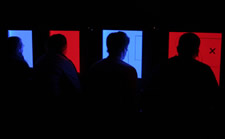Red light, blue light
 Two things from a recently published study by researchers at RPI's Lighting Research Center:
Two things from a recently published study by researchers at RPI's Lighting Research Center:
1. That sleepy feeling after lunch has a name: the "post-lunch dip."
2. Light, especially red light, might be able to help counteract the dip.
The researchers hooked people up to EEGs to measure brain activity and then exposed them to red (longer wave length) and blue light (shorter wave length). From the abstract:
While the use of light at night to promote alertness is well understood, it is important to develop an understanding of how light impacts alertness during the daytime, especially during the post-lunch hours. The aim of the current study was to investigate how 48-minute exposures to short-wavelength (blue) light ... or long-wavelength (red) light ... close to the post-lunch dip hours affect electroencephalogram measures in participants with regular sleep schedules. Power in the alpha, alpha theta, and theta ranges was significantly lower (p < 0.05) after participants were exposed to red light than after they remained in darkness. Exposure to blue light reduced alpha and alpha theta power compared to darkness, but these differences did not reach statistical significance (p > 0.05). The present results extend those performed during the nighttime, and demonstrate that light can be used to increase alertness in the afternoon, close to the post-lunch dip hours.
The researchers say the work could lead to better understanding how light affects alertness and fatigue in safety situations.
In the meantime, we've found (unscientifically) that a cup of tea helps address the post-lunch dip.
photo: RPI Lighting Research Center
Hi there. Comments have been closed for this item. Still have something to say? Contact us.
Comments
The best cure for the post-lunch dip is a 20 minute nap.
... said chezjake on Apr 23, 2013 at 3:29 PM | link